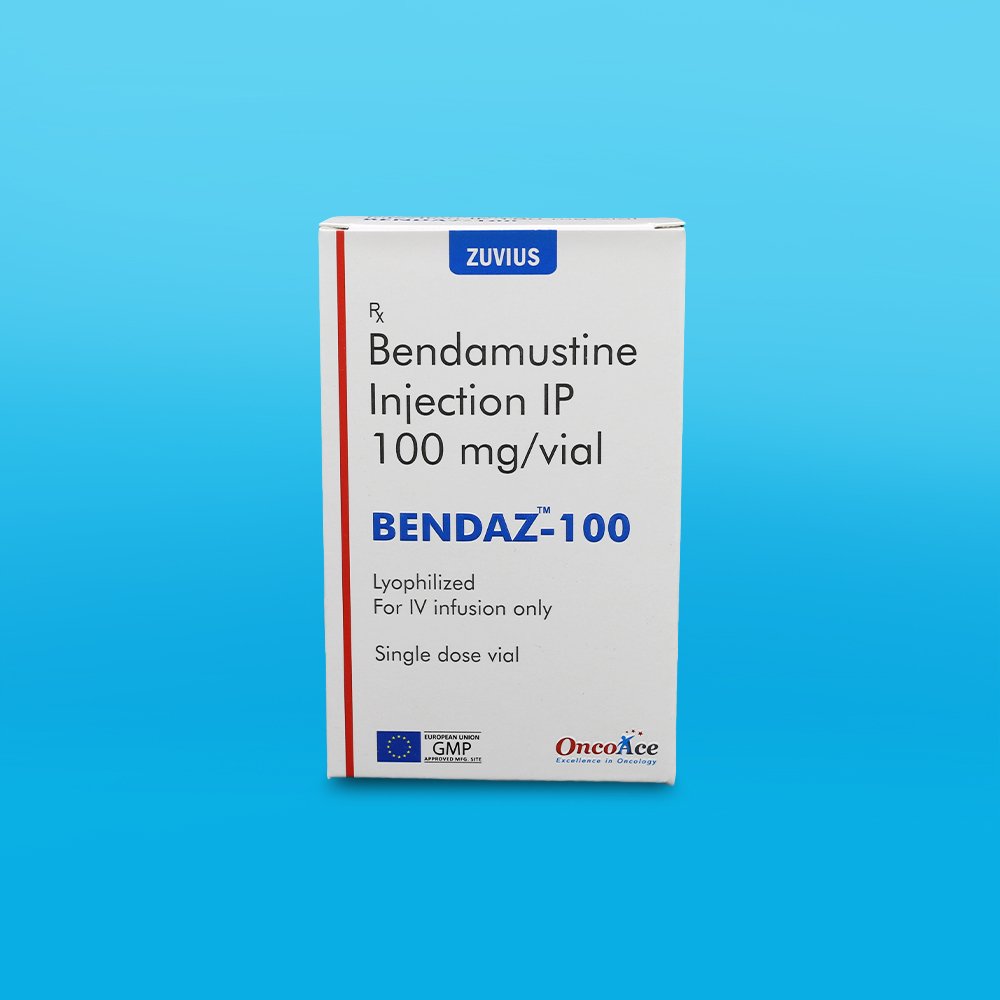Bendaz 100 mg- Bendamustin Injection 100 mg
Bendamustin Injection
Strength: 100 mg
Pack Size: Vial
Drug Class: Alkylating Agents
Dosage and Administration:
- Bendamustine hydrochloride is available in two formulations, a solution (Bendamustine Injection) and a lyophilized powder (Bendamustine for Injection).
- For CLL: 100 mg/m2 infused intravenously over 30 minutes on Days 1 and 2 of a 28-day cycle, up to 6 cycles
- For NHL: 120 mg/m2 infused intravenously over 60 minutes on Days 1 and 2 of a 21-day cycle, up to 8 cycles
Cold Storage: no
Bendamustine is a nitrogen mustard drug indicated for use in the treatment of chronic lymphocytic leukemia (CLL) and indolent B-cell non-Hodgkin lymphoma (NHL) that has progressed during or within six months of treatment with rituximab or a rituximab-containing regimen. Bendamustine is a bifunctional me chlorethamine derivative capable of forming electrophilic alkyl groups that covalently bond to other molecules.
Bendamustine Hydrochloride for Injection is an alkylating drug indicated for treatment of patients with:
Chronic lymphocytic leukemia (CLL). Efficacy relative to first line therapies other than chlorambucil has not been established.
Indolent B-cell non-Hodgkin lymphoma (NHL) that has progressed during or within six months of treatment with rituximab or a rituximab-containing regimen
Bendamustine has demonstrated significant efficacy across multiple studies in various hematologic malignancies. In patients with rituximab-refractory, indolent B-cell non-Hodgkin lymphoma (NHL), a Phase III study showed superior overall response rates (68% vs 39%), longer median progression-free survival (21.7 vs 9.3 months), and prolonged remission duration (18.9 vs 6.1 months) compared to chlorambucil. Another study in rituximab-refractory NHL reported an overall response rate of 84% with bendamustine monotherapy, including a 29% complete response rate, and a median progression-free survival of 9.7 months. Bendamustine has also shown efficacy in multiple myeloma (MM) and has approvals in Europe for MM, NHL, chronic lymphocytic leukemia (CLL), breast cancer, and Hodgkin lymphoma, with primary dose-limiting toxicity being hematologic.patients.
- Pregnancy: The use of bendamustine should be avoided during pregnancy, particularly during the first trimester.
- Breastfeeding: It is not recommended to breastfeed during treatment with bendamustine due to the potential for serious adverse reactions in nursing infants.
- Fertility: Bendamustine may impair fertility in both men and women. Women of childbearing potential should use effective contraception during treatment with bendamustine. Men should consider sperm preservation before starting bendamustine therapy, as it may lead to temporary or permanent infertility.
Teratogenicity: Pregnancy testing and effective contraception are recommended during and for at least six months after treatment with bendamustine to minimize the risk of fetal exposure
- Myelosuppression: Delay or reduce dose and restart treatment based on ANC and platelet count recovery.
- Infections: Monitor for fever and other signs of infection or reactivation of infections and treat promptly.
- Progressive multifocal leukoencephalopathy (PML): Monitor for new or worsening neurological, cognitive or behavioral signs or symptoms suggestive of PML.
- Anaphylaxis and Infusion Reactions: Severe and anaphylactic reactions have occurred; monitor clinically and discontinue drug for severe reactions. Pre-medicate in subsequent cycles for milder reactions.
- Tumor Lysis Syndrome: May lead to acute renal failure and death; anticipate and use supportive measures in patients at high risk.
- Skin Reactions: Discontinue for severe skin reactions. Cases of SJS, DRESS and TEN, some fatal, have been reported.
- Hepatotoxicity: Monitor liver chemistry tests prior to and during treatment.
- Other Malignancies: Pre-malignant and malignant diseases have been reported.
- Extravasation Injury: Take precautions to avoid extravasation, including monitoring intravenous infusion site during and after administration.
- Embryo-Fetal Toxicity: Can cause fetal harm. Advise females of reproductive potential of the potential risk to a fetus and to use an effective method of contraception.






